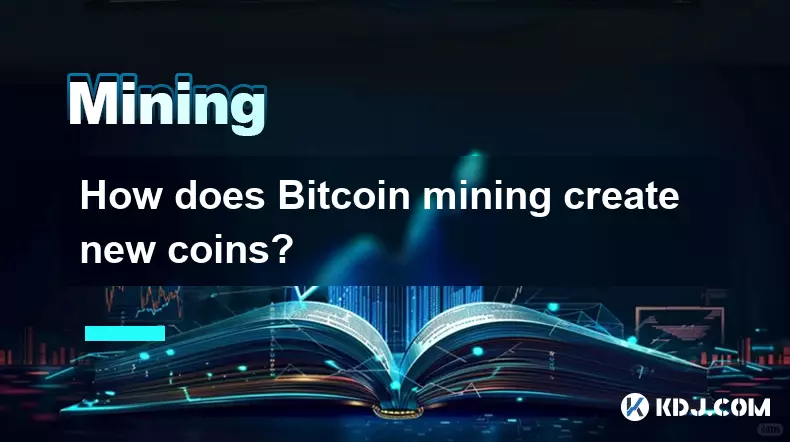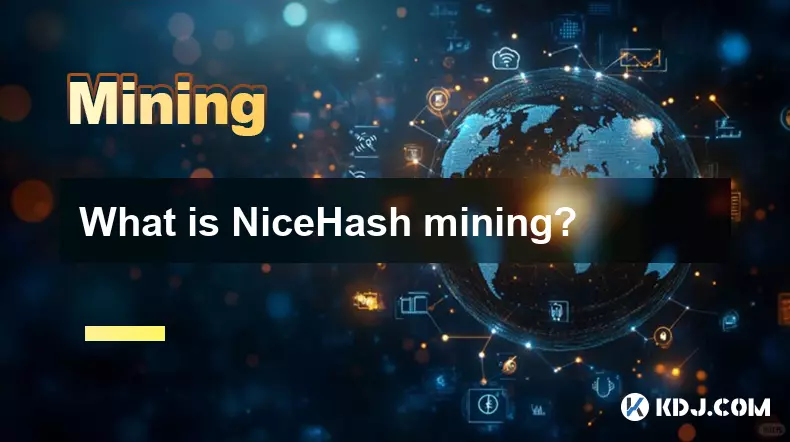-
 bitcoin
bitcoin $101752.865364 USD
-1.09% -
 ethereum
ethereum $3382.985899 USD
-1.38% -
 tether
tether $0.999658 USD
0.04% -
 xrp
xrp $2.272505 USD
-1.51% -
 bnb
bnb $989.089004 USD
0.14% -
 solana
solana $156.962612 USD
-3.08% -
 usd-coin
usd-coin $0.999776 USD
0.01% -
 tron
tron $0.290786 USD
-0.69% -
 dogecoin
dogecoin $0.174594 USD
-2.86% -
 cardano
cardano $0.560085 USD
-3.55% -
 hyperliquid
hyperliquid $40.023704 USD
-5.75% -
 chainlink
chainlink $15.324649 USD
-2.78% -
 bitcoin-cash
bitcoin-cash $493.576540 USD
-3.52% -
 zcash
zcash $571.320038 USD
-12.05% -
 stellar
stellar $0.280066 USD
-4.26%
How does Bitcoin mining create new coins?
Bitcoin mining creates new coins through a competitive, energy-intensive process where miners solve complex puzzles to validate transactions and earn block rewards, which halve every 210,000 blocks to ensure a capped supply of 21 million BTC.
Nov 06, 2025 at 12:00 am

How Bitcoin Mining Creates New Coins
1. Bitcoin mining is the process through which new bitcoins are introduced into circulation, and it plays a vital role in maintaining the integrity of the blockchain network. Miners use powerful computers to solve complex cryptographic puzzles, validating transactions and securing the network. When a miner successfully solves a block’s puzzle, they are rewarded with a set number of newly minted bitcoins. This reward is known as the block reward.
2. The mining process begins when users initiate Bitcoin transactions. These transactions are grouped into blocks by nodes on the network. Miners then compete to validate these blocks by finding a specific hash value that meets the network’s difficulty target. This requires significant computational power and energy. Once a valid hash is found, the block is added to the blockchain, and the miner receives the block reward.
3. The block reward consists of two parts: the newly created bitcoins and transaction fees paid by users. Initially, the block reward was 50 BTC per block. However, Bitcoin is designed with a mechanism called halving, which reduces the reward by half approximately every four years, or after every 210,000 blocks are mined. This scarcity model ensures that the total supply of Bitcoin will never exceed 21 million.
4. As of now, the block reward stands at 6.25 BTC, following the most recent halving event. This system incentivizes miners to continue supporting the network even as the block rewards decrease over time. Transaction fees are expected to become a more significant portion of miner income in the future, especially as the block reward diminishes further.
5. The decentralized nature of Bitcoin mining ensures that no single entity controls coin creation. Instead, the protocol automatically issues new coins according to a predetermined schedule. This algorithmic issuance prevents inflation and central manipulation, reinforcing Bitcoin’s value proposition as digital gold.
The Role of Consensus and Network Security
1. Bitcoin relies on a consensus mechanism called Proof of Work (PoW) to ensure all participants agree on the state of the blockchain. Miners contribute computing power to secure the network, making it extremely difficult for malicious actors to alter transaction history. The energy-intensive nature of PoW acts as a deterrent against attacks.
2. Each new block must reference the previous block’s hash, creating an immutable chain. If someone attempts to change a past transaction, they would need to re-mine all subsequent blocks, requiring more than 50% of the network’s total hashing power—a scenario known as a 51% attack. Due to the vast scale of the Bitcoin network, such an attack is economically unfeasible.
3. The difficulty of mining adjusts roughly every two weeks to maintain a consistent block time of about 10 minutes. This adjustment ensures that new coins are released at a predictable rate, regardless of how much mining hardware enters or leaves the network.
4. By aligning financial incentives with network security, Bitcoin ensures that miners act honestly. Attempting to cheat the system would result in wasted resources and lost rewards, while legitimate mining yields steady returns in the form of new bitcoins and fees.
5. This self-regulating economic model makes Bitcoin resilient and trustless, allowing anyone to verify transactions without relying on intermediaries.
Economic Incentives Behind Mining
1. Mining profitability depends on several factors, including electricity costs, hardware efficiency, and the current market price of Bitcoin. Miners often operate in regions with cheap electricity to maximize margins. Large-scale mining farms have emerged globally, contributing to the network’s overall hash rate.
2. As the block reward decreases over time, competition among miners intensifies. Only the most efficient operations can remain profitable, leading to continuous innovation in mining technology and infrastructure.
3. The issuance of new coins through mining serves as both a distribution mechanism and a security measure, ensuring that Bitcoin remains decentralized and resistant to censorship.
4. Unlike traditional monetary systems where central banks control money printing, Bitcoin’s issuance is transparent, predictable, and governed by code. Anyone can audit the blockchain to verify the total supply and confirm that no additional coins are created outside the protocol rules.
5. Over time, the reliance on transaction fees will grow. Users who prioritize faster confirmations can pay higher fees, creating a market-driven incentive structure that supports long-term network sustainability.
Frequently Asked Questions
What happens when all 21 million Bitcoins are mined?Once the maximum supply is reached, estimated around the year 2140, no new bitcoins will be created. Miners will rely solely on transaction fees for income. The network is designed to remain secure and functional under this model, assuming sufficient user activity and fee levels.
Can miners create bitcoins arbitrarily?No. The Bitcoin protocol strictly enforces the issuance schedule. Any attempt to create extra coins would be rejected by the network’s nodes, as all participants follow the same consensus rules. This immutability is fundamental to Bitcoin’s trustless design.
How often does the mining reward halve?The block reward halves approximately every four years, or more precisely, every 210,000 blocks. This predictable reduction continues until the last bitcoin is mined, ensuring a controlled and deflationary supply model.
Is Bitcoin mining still profitable today?Profitability varies based on location, equipment, and Bitcoin’s market price. While individual hobbyists may struggle to compete with industrial operations, many large mining companies continue to invest heavily, indicating that mining remains viable under optimal conditions.
Disclaimer:info@kdj.com
The information provided is not trading advice. kdj.com does not assume any responsibility for any investments made based on the information provided in this article. Cryptocurrencies are highly volatile and it is highly recommended that you invest with caution after thorough research!
If you believe that the content used on this website infringes your copyright, please contact us immediately (info@kdj.com) and we will delete it promptly.
- Ripple (XRP) in 2026: Hold or Fold? A Look at XRP's Future and Emerging DeFi Alternatives
- 2025-11-08 18:35:01
- Zcash ZEC Coin Price Explosion: From Privacy Niche to Center Stage
- 2025-11-08 18:55:01
- Berachain Price Prediction: Navigating the Honeycomb Hype in Crypto
- 2025-11-08 18:55:01
- Arthur Hayes, Gold, and Bitcoin: A Modern Monetary Trinity?
- 2025-11-08 19:15:01
- Shiba Inu's Next Move: Navigating a Shifting Market
- 2025-11-08 19:20:01
- Pakistan's Crypto Crossroads: Balancing Opportunity with Asset-Backed Realities
- 2025-11-08 19:20:01
Related knowledge

What is the block reward in mining?
Nov 06,2025 at 12:35am
Understanding Block Rewards in Cryptocurrency Mining1. The block reward is the incentive miners receive for successfully validating and adding a new b...

How do mining algorithms work?
Nov 06,2025 at 04:59am
Mining Algorithms and Their Role in Blockchain Networks1. Mining algorithms serve as the backbone of blockchain consensus mechanisms, ensuring that tr...

What is NiceHash mining?
Nov 06,2025 at 07:40am
NiceHash mining refers to the process of renting out computational power to individuals or organizations seeking to mine cryptocurrencies without owni...

Does an antivirus program affect mining?
Nov 05,2025 at 09:29pm
Understanding Decentralized Exchanges in the Crypto Ecosystem1. Decentralized exchanges (DEXs) operate without a central authority, allowing users to ...

What is the history of Bitcoin mining?
Nov 05,2025 at 08:15pm
Within the fast-moving world of cryptocurrency, new developments emerge daily, reshaping how investors, developers, and institutions interact with dig...

How is the energy consumption of mining justified?
Nov 05,2025 at 10:20pm
Energy Consumption in Cryptocurrency Mining1. The energy consumption associated with cryptocurrency mining has drawn significant attention from enviro...

What is the block reward in mining?
Nov 06,2025 at 12:35am
Understanding Block Rewards in Cryptocurrency Mining1. The block reward is the incentive miners receive for successfully validating and adding a new b...

How do mining algorithms work?
Nov 06,2025 at 04:59am
Mining Algorithms and Their Role in Blockchain Networks1. Mining algorithms serve as the backbone of blockchain consensus mechanisms, ensuring that tr...

What is NiceHash mining?
Nov 06,2025 at 07:40am
NiceHash mining refers to the process of renting out computational power to individuals or organizations seeking to mine cryptocurrencies without owni...

Does an antivirus program affect mining?
Nov 05,2025 at 09:29pm
Understanding Decentralized Exchanges in the Crypto Ecosystem1. Decentralized exchanges (DEXs) operate without a central authority, allowing users to ...

What is the history of Bitcoin mining?
Nov 05,2025 at 08:15pm
Within the fast-moving world of cryptocurrency, new developments emerge daily, reshaping how investors, developers, and institutions interact with dig...

How is the energy consumption of mining justified?
Nov 05,2025 at 10:20pm
Energy Consumption in Cryptocurrency Mining1. The energy consumption associated with cryptocurrency mining has drawn significant attention from enviro...
See all articles





















![The Graph Price Prediction [GRT Crypto Price News Today] The Graph Price Prediction [GRT Crypto Price News Today]](/uploads/2025/11/07/cryptocurrencies-news/videos/690d4df44fe69_image_500_375.webp)




















































